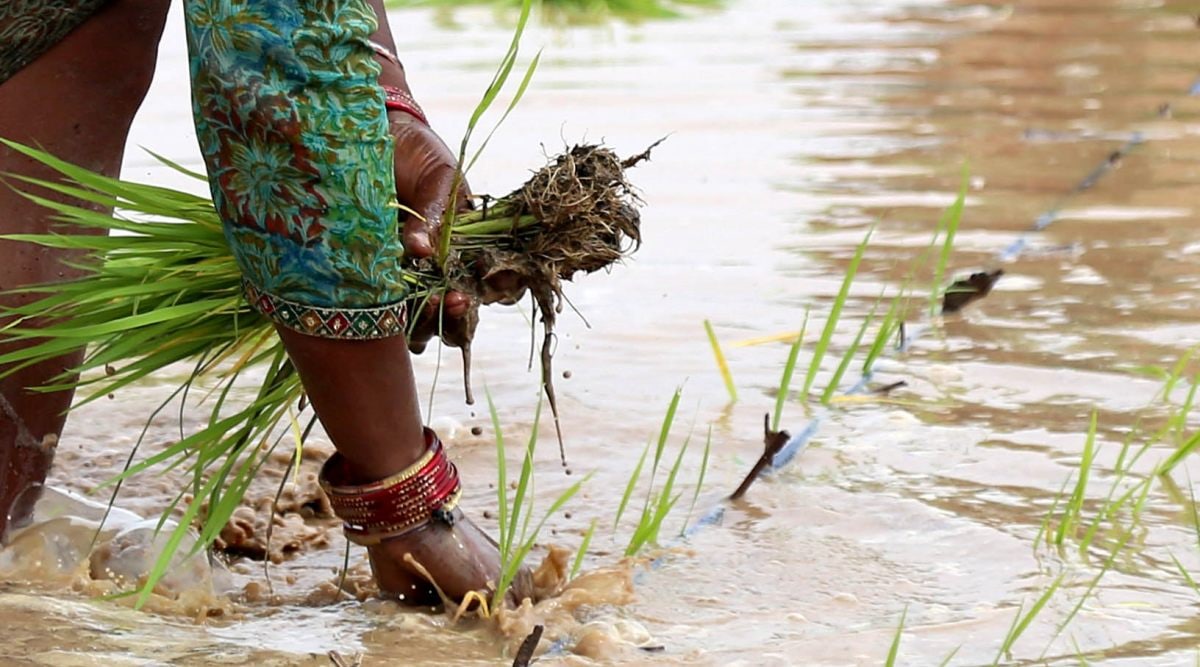 While rain filled fields, Women workers plants paddy in Ludhiana. (Express Photo by Gurmeet Singh )
While rain filled fields, Women workers plants paddy in Ludhiana. (Express Photo by Gurmeet Singh ) Has Punjab been able to reduce five lakh hectares (12.35 lakh acres) under water-guzzling paddy (non-basmati) and shift it to other crops in the last two years? Despite Punjab Agriculture Department repeatedly claiming to have done so and CM’s office relying on the same figures in its statements, data from the office of the Director of Land Records, Punjab (Revenue Department), does not support this tall claim.
While Agriculture Department has been claiming that area under paddy came down from 25.92 lakh hectares (LHS) in 2018-2019 to 20.86 LHS in 2020-21, the state’s Land Records Department claims that in 2020-21 area under paddy rice was 27.43 LHS, which is in fact highest ever in the history of paddy cultivation in the state.
Punjab needs to reduce the area under paddy rice only, and not under basmati rice, which is one of the alternatives for paddy.
The Punjab government has been making a lot of efforts to divert the area under paddy to other kharif crops like basmati, maize and cotton but it seems little has changed on the ground.
Different depts, different claims
According to the records of the Punjab Agriculture Department there was 31.03 lakh hectares (LHS) area under paddy (non-basmati) and basmati crops in 2018-19. This included 25.92 LHS under paddy and 5.11 LHS under basmati.
Next year in 2019-20, the Agriculture Department targeted to reduce 2 lakh hectares under paddy and at the end of sowing in first week of August, the department’s record revealed on August 26, 2019 that total area under rice was recorded 29.20 LHS, including 22.90 LHS area under paddy (non basmati, parmal rice) and 6.29 LHS under basmati. This meant that total 1.83 LHS area was reduced under rice including 3 LHS under paddy (non-basmati) itself.
Then in 2020-21, Agriculture department said that rice area had recorded another big reduction at 27.36 LHS against 29.20 LHS in the previous season. This was again a reduction of 1.84 LHS under rice in total. In this 27.36 LHS rice area, 6.50 LHS was shown under basmati and remaining 20.86 LHS under paddy. This meant another 2.05 LHS reduction under paddy itself.
By these calculations from 2018 to 2020, the Agriculture Department had shown a reduction of 3.67 LHS under total rice cultivation, and 5.06 LHS under paddy.
But the office of Director of Punjab Land Records, contradicts these claims.
The starting point of these diversification claims was year 2018-19. For this year, figures of both departments for areas under paddy are the same (25.92 LHS). But going forward the figures vary.
According to the Director Punjab Land Records, the area under rice in 2019-20 increased by 39,000 hectares making 31.42 LHS including paddy on 25.13LHS. In the next season, 2020-21, it touched 27.43 LHS – the highest in the history of paddy cultivation in the state.
In fact for 2020-21, the area under rice (paddy and basmati) was 31.49 LHS, again the highest ever under rice in the state.
So in the last two seasons, there has been an increase of 1.5 LHS in area under paddy from 25.92 LHS to 27.43 LHS, according to the Land Records Department.
Further, the Agriculture Department had shown that the area under paddy was diverted to basmati, cotton and maize in these two years.
According to Agriculture Department basmati, cotton and maize area has increased in these two years.
Under basmati it increased from 5.11 LHS in 2018 to 6.29 LHS in 2019 and then to 6.50 LHS in 2020. In case of cotton, it increased from 2.67 LHS in 2018 to 3.91 LHS in 2019 and then 5.01 LHS in 2020.
For maize, the Agriculture Department, said that the area rose from 1.09 LHS in 2018 to 1.60 LHS in 2019 and then to 2.42 LHS in 2020. So in two years the area under basmati increased by 1.39 LHS, area under cotton increased by 2.53 LHS and under maize it rose by 1.39 LHS, according to the state Agriculture Department’s claims.
But here again the Punjab Land Records office data reveals that the area under cotton remained 2.48 LHS in 2019 and then at 2.52 LHS in 2020, which means a decrease of just 15,000 hectares from 2018 figure.
Even basmati area in 2020 was 4.06 LHS, according to the Land Records office, while Agriculture Department data showed that it was 6.50 LHS — an increase of 2.50 LHS.
- The Indian Express website has been rated GREEN for its credibility and trustworthiness by Newsguard, a global service that rates news sources for their journalistic standards.

